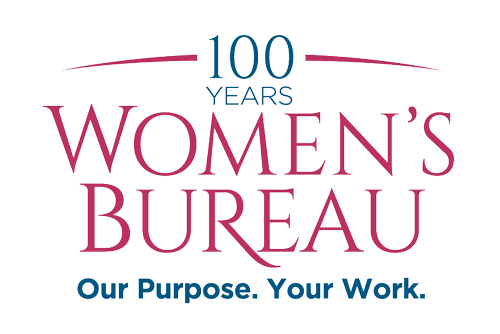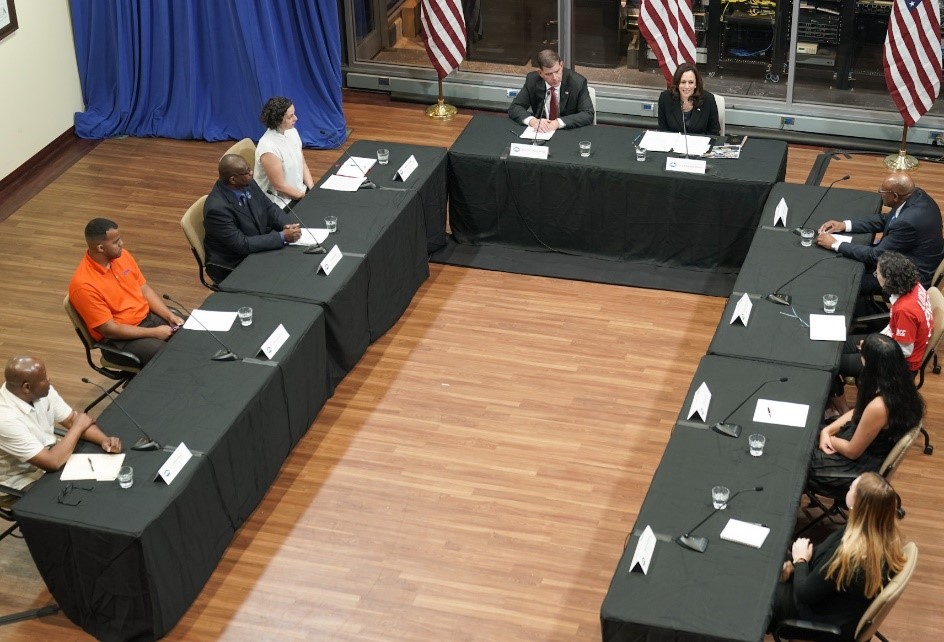
Dear Friends of the Women's Bureau,
While the economy has made gains in recent months, especially in woman-dominated sectors such as education and hospitality, the most recent Jobs Report showed over 2 million fewer prime-age working women than there were prior to the pandemic. We’re striving to turn this around, to continue to rebuild the labor force, and to get women working.
One key stumbling block is the continued unmet need for childcare. Mothers of young children remain some of the hardest-hit in terms of employment. Data from the U.S. Census Bureau Household Pulse Survey indicates that as recently as May, 4.1 million women were living in households where children were unable to attend day care or school because of the pandemic. How are these households coping? In 2.7 million of them, an adult either left or lost their job; reduced their hours; or opted not to look for a job. In other words, limitations on childcare are creating limitations on labor-force participation, especially for women, who typically take on more caregiving responsibilities. We know that childcare IS the bridge to work, and without it, work can be impossible for those who are otherwise eager to join the labor force. We’ve been calling attention to this, through speaking engagements and in ongoing research projects, and will continue to do so as we push to build the care infrastructure our country needs.
We’ve also just launched a $1.5 million funding opportunity to support a #KnowYourRights campaign led by a diverse set of community partners, aimed at helping women workers understand and access their labor rights and benefits. The American Rescue Plan delivered some key investments, but they’re only meaningful if people know about them and can access them.
Furthermore, we’ve kicked off a multi-week online dialogue where we want to hear what your thoughts are on how to improve working conditions for women.
Read more on both the #KnowYourRights campaign and the dialogue on working conditions below, including how you can share your ideas with us, to help us build a new normal for all working women.
Sincerely,
Wendy Chun-Hoon
Director
Women’s Bureau
U.S. Department of Labor
Funding Alert: $1.5 million to Inform Women About Labor Rights and Benefits

The U.S. Department of Labor recently announced a $1.5 million funding opportunity available to all 50 states, the District of Columbia, Puerto Rico, the U.S. Virgin Islands, Guam, American Samoa and the Northern Mariana Islands to develop partnerships with community-based organizations and other non-profits to conduct outreach to women workers to help them understand and exercise their rights and benefits in the workplace. The fund will support up to six grants.
Administered by the department’s Women’s Bureau and the Employment and Training Administration, the Fostering Access, Rights and Equity (FARE) grants are designed to help low-wage women workers.
DOL Hosts Dialogue to Promote Employment Equity for Women Workers
The U.S. Department of Labor has launched a national online dialogue to gather ideas to improve labor outcomes for women, especially economically disadvantaged women. The Women’s Bureau is co-hosting the dialogue along with the department’s Office of Disability Employment Policy, Employment and Training Administration, Wage and Hour Division, and Office of Federal Contract Compliance Programs.
The dialogue will be open until July 9, and the input received will help identify strategies for dismantling the systemic barriers to employment and participation in workforce services women face. The dialogue’s themes will include:
- Ensuring equity in the American Jobs Plan.
- Promoting gender equity in the workplace.
- Ensuring equitable access to paid leave.
- Creating safe and welcoming workplaces.
- Adapting to a changing labor market.
"Women’s economic empowerment is central to realizing women’s rights and gender equality. These dialogues seek to understand the barriers that continue to limit the full participation of women in the workplace,” said Women’s Bureau Director Wendy Chun-Hoon. “At the same time, we want to determine how best to provide resources we know lift up women workers and create a more equitable economy. We appreciate our stakeholders weighing in on these important issues.”
The dialogue is open to anyone interested in providing their input on these important issues.
- Register to participate in the online dialogue
In addition to the ongoing online dialogue, there will be a live Twitter chat on 7/7 from 2-3 ET.
Follow #EPWChat then to join with other stakeholders in a real-time discussion about these issues crucial to women in the workplace.
Women's Bureau Anniversary Blog: Building on a Century of Progress

The Women’s Bureau Director wrote a blog celebrating the 101st anniversary of the agency. The blog reflects on the collective challenges the Women’s Bureau has worked on and also looks to the future of what more needs to be done to support all working women.
Equal Pay Act Anniversary Blog: Let’s Make Equal Pay a Reality

Women’s Bureau Regional Administrator Charmaine Davis wrote a blog commemorating the passage of the Equal Pay Act 58 years ago on June 10, 1963. The blog makes note that despite the decades that have passed, equal pay is still not a reality for women, especially women of color. On average, women working full-time, year-round earned $47,299 in 2019 while men working full-time, year-round earned $57,456.
Paid Leave Blog: Even Prior to Pandemic, Working Women Couldn’t Take Time Off When They Needed

Women’s Bureau survey statistician Gretchen Livingston wrote a blog highlighting analysis of the 2017-2018 American Time Use Survey Leave Module, a nationally-representative survey by the Bureau of Labor Statistics sponsored by the Women’s Bureau. Even before COVID, many were in the position of needing time off, but not being able to take it. Among all working women in the U.S., 1 in 10 had that exact experience in the month prior to being surveyed.
Blog: Supporting America’s Workers

Women’s Bureau Director Wendy Chun-Hoon and the acting Assistant Secretary of Labor for OSHA published a blog about how DOL supports workers through improving equity, partnering to educate workers, and funding safety training. The blog discusses how WB’s Fostering Access, Rights, and Equity (FARE) grant program and OSHA’s Susan Harwood Training grant program improve working conditions and ensure all workers know their rights and benefits.
WB in the Community
Check out some recent speaking engagements featuring Women’s Bureau Director Wendy Chun-Hoon:
- 2021 Aspen Forum on Children and Families, Bringing 2Gen to Life: Taking Equitable and Effective Actions for Families (panel starts at 2:35:05)
- The 19th Represents: Building a Caregiving Economy for All
- The Paychex Business Series Podcast with Gene Marks, Women in the Workplace: The Past, the Present, and the Future
Vice President and Secretary Walsh Promote Child Tax Credit Awareness Day

- The White House declared June 21, 2021, to be Child Tax Credit Awareness Day. Secretary Walsh traveled to Pittsburgh, PA, with Vice President Harris to visit the Brookline Recreation Center and discuss the Child Tax Credit expansion, which is contained in the American Rescue Plan, signed into law on March 11, 2021. Key aspects of the expansion include: IIn 2021, for most families, the Child Tax Credit is increased to $3,000 for each child between 6 and 17 years old and to $3,600 for each child under age 6.
- Starting in July, Child Tax Credit payments will be provided monthly in payments of up to $250-300 per child, depending on the age of the child.
- The Child Tax Credit is now fully refundable, meaning that if a family’s income-tax bill is less than the amount of their Child Tax Credit, they will get a payment for the difference.
- Families that filed taxes in 2019 or 2020, or signed up for Economic Impact Payments, will receive the Child Tax Credit automatically.
- Other eligible families can still sign up to receive monthly Child Tax Credit payments beginning this summer.
- Learn more about the Child Tax Credit
- Read Secretary Walsh’s comments on the Brookline Recreation Center visit
DOL Participates in Technical Exchange with European Commission
DOL participated in a virtual technical exchange with the European Commission on efforts to serve vulnerable populations during the COVID-19 crisis, with representatives from DOL’s Office of the Assistant Secretary for Policy, Women’s Bureau, Office of Disability Employment Policy, and the Employment and Training Administration. Participants in the technical exchange discussed specific challenges that youth and young adults, older workers, women, and individuals with caregiving responsibilities are encountering during the crisis; what we can learn from these challenges; and what services are needed to deal with these challenges future. Participants[BS-O1] [BS-O2] also discussed what efforts by members of the civil society, employers and trade unions are generally useful in assisting the vulnerable populations.
Data Update: Earnings

The Women’s Bureau recently posted updated, interactive statistics on median annual earnings. Earnings are disaggregated by sex, race, Hispanic ethnicity, and educational attainment. Among other findings, Asian men had the highest median annual earnings at $75,671 while Hispanic women had the lowest at $36,110.
Census: Household Pulse Survey Interactive Tool

The U.S. Census Bureau recently released an interactive data tool for the Household Pulse Survey. Users can select different questions from the survey in categories including education, employment, food sufficiency, health, housing, spending, and transportation, and filter by state or metro area, and by survey week.
Share Your Story With Us

The Women’s Bureau has been collecting stories from women to learn about how they are navigating work, family, and the economy in the midst of the Covid-19 pandemic--their struggles, their coping strategies, and their ideas about what would help them succeed.
Please consider sharing your story with us, so we can continue to create an economy that works for women.
Hear from women who have already shared their stories: Ashley Bostick, member leader with 9to5 Georgia; Christina Hayes, volunteer for Mothering Justice; Nour Quytan, restaurant worker with the Restaurant Opportunities Center; Rev. Harriet Bradley, health care worker; and Daniella Knight, part-time worker and mom.
Follow the Women's Bureau on Twitter: @WB_Dol

The Women’s Bureau has championed the rights of working women and served as a convener of conversations for the past 100 years.
Follow us at @WB_DOL to view our #FridayFirsts series highlighting pioneering women, and to learn more about the latest research, initiatives, policies, and updates related to working women. We look forward to continuing the thoughtful conversations on Twitter that we've had with our stakeholders for the last 100 years!
